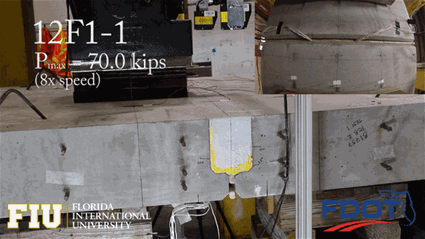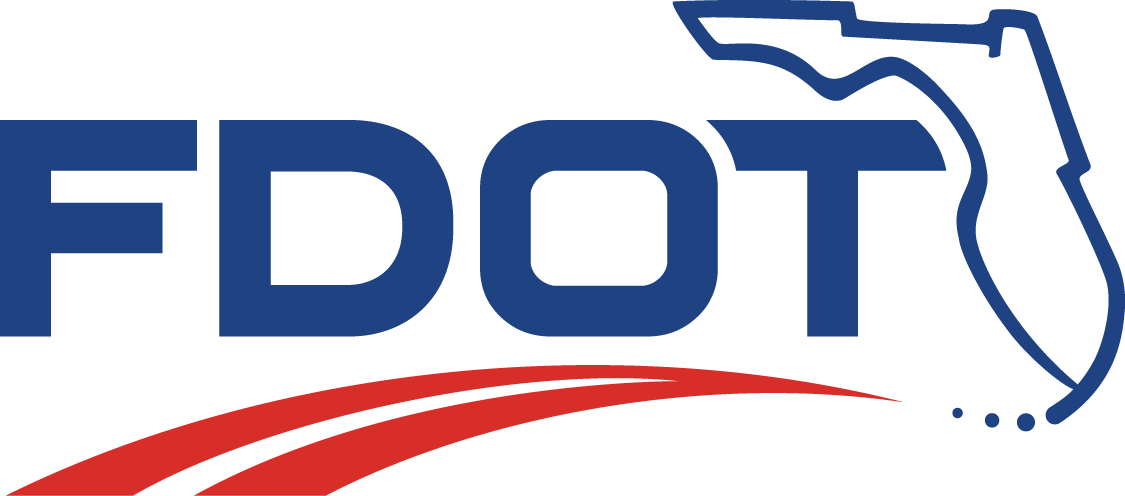Structures Design
Structures Design - Transportation Innovation
Ultra-High Performance Concrete (UHPC) |
 |
| |
Overview
Ultra High Performance Concrete (UHPC) is part of FHWA's Every Day Counts intended to highlight some advantages
of accelerated project delivery and long-term durability minimizing repairs and future disruption to traffic. Both the FHWA and FDOT support the use of accelerated project delivery techniques such as UHPC and Prefabricated Bridge Elements and
Systems (PBES) as an economical way to increase quality, reduce long-term maintenance costs and construction time, which indirectly supports safety. Use of these innovative concepts aids in solving many constructability and durability challenges,
while potentially revolutionizing bridge construction in the United States.
The deterioration of reinforcing and prestressing steel within concrete elements and connections is one of the prime causes of failure of concrete structures. In addition to being exposed to weather, concrete transportation structures in Florida are also commonly located in aggressive environments such as marine locations and inland water crossings where the water is acidic. Cracks in concrete create paths for the agents of the aggressive environments to reach the reinforcing and/or prestressing steel and begin the corrosive oxidation process. An innovative approach to combat this major issue is to replace traditional concrete with UHPC in either or both the connections and precast elements.
Beneficial characteristics of UHPC include:
- High resistance to chloride ion and chemical attack
- High tensile strength (1-2 ksi)
- Post cracking ductility (greater than 0.006 strain at failure)
- High compressive strength (greater than 17 ksi)
- High early compressive strength (14 ksi in 24 hours)
Like any construction material, there are pros and cons to the use of UHPC:
- Due to its ultra-high compressive strength and significant post-cracking tensile strength, current design codes are not applicable without significant modification. Engineers must familiarize themselves with the applicable technical guidelines that have been issued by FHWA, and Specifications in development by AASHTO member agencies.
- Due to the complex chemistry in the UHPC, the mix design and batching process are more extensive compared to conventional concrete. As such many of the successful UHPC mix designs are proprietary.
- Storage and handling requirements for prebagged mixes on the construction site can be more restrictive than typical grouting operations.
- The initial cost of UHPC is considerably higher than that of traditional concrete. However, this higher initial cost may be partially offset by a reduction in the concrete volumes, lighter handling weights and speed of construction. A longer service
life of the concrete component may also be expected if UHPC is used by reducing the need for repairs and eliminating cathodic protection or sacrificial anodes in reinforced and prestressed concrete elements.
Due diligence must be done to ensure UHPC benefits outweigh the costs of implementation for each concrete component. However, the use of this innovative material in certain Florida bridge connections and components will keep Florida on the leading edge in the design of state-of-the-art transportation facilities.
These usage restrictions take into consideration the following items:
See the following references for the application of UHPC for concrete reinforcement:
- Ultra-High Performance Concrete: A State-of-the-Art Report for the Bridge Community (FHWA-HRT-13-060)
- Design and Construction of Field-Cast UHPC Connections (FHWA-HRT-14-084)
- Field Testing of an Ultra-High Performance Concrete Overlay (FHWA-HRT-17-096)
- Properties and Behavior of UHPC-Class Materials (FHWA-HRT-18-036)
- FHWA Every Day Counts EDC 3 Final Report, pg. 52, May 2017. (discusses FDOT UHPC projects)
Additional design and detailing criteria are currently under development for the FDOT Structures Manual
The potential use of UHPC for a given application will be evaluated on a project by project basis. Extensive coordination with the Structures Design Office will initially be required in order to develop acceptable final designs.
Developmental Specifications Dev 349 and Dev 927 are available on the Developmental Specifications webpage for the use of prebagged proprietary UHPC mixes. Additional Developmental Specifications for ready-mix UHPC will be prepared and made available on an as-needed basis.
UHPC products are currently approved on a project specific basis in accordance with the contract specifications, typically using Dev927UHPC or Technical Special Provision (TSP).
FDOT and affiliated projects in Florida can be explored using the FHWA GIS-Mapping Tool.
Please contact the coordinators at the bottom of the page to have your project included in the Map.
Fast-Facts sheets for selected projects are listed below:
- I-10 over CR268A Approach Slab Replacement
- I-10 over Flat Creek Approach Slab Replacement
- I-95 over CR5A - Precast Deck Panel Replacement
- I-95/JT Butler Interchange Bridge U-Beam Repair
- SR 115/Arlington Expy over Red Bar Branch
- SR25(US27) NB over Fisheating Creek
- SR 714/Danforth Creek - Sonovoid Rehab
- SR 924/NW 119th St over Rio Vista Canal
- SR 994/Quail Roost Dr over Canal C-102
- US1 over Little Duck Key Channel
- US441 over Taylor Creek - Span 12 Replacement
- US41 over Sunset Waterway Link-Slab
- CR339/Waccasassa River Pile Demonstration
- Large Bars Spliced in UHPC for Bridge Substructure Connections (FDOT-SRC), Final Report (2023)
- Florida Slab Beam Bridge with Ultra-High Performance Concrete Joint Connections (FIU, BDV29 977-28 & 65), Summary, Final Report (2021)
- “Joint Design Optimization for Accelerated Construction of Slap Beam Bridges”, F. D. Chitty, C. J. Freeman, and D. B. Garber. Journal of Bridge Engineering, vol. 25, no. 7. p. 04020029-14, 2020
- Hybrid Prestressed Concrete Bridge Girders using UHPC (UF, BDV31-977-101), Summary, Final Report (2021)
- Requirements for Use of Field-Cast, Proprietary Ultra-High-Performance Concrete in Florida Structural Applications (UF, BDV31-977-94), Summary, Final Report (2019)
- • Synthesis Study Quantifying the Effect of UHPC Fiber Dispersion and Orientation in Structural Members (FAMU-FSU, BDV30-977-34), Summary, Final Report (Nov. 2021)
- Ultra-High Performance concrete use in Florida Structural Applications (UF. BDV31-977-105), Summary, Final Report (2022)
Technology Transfer (T2)
- 2023 Southeastern Bridge Preservation Partnership Meeting – “UHPC Update from FDOT” (Sept 9)
- 2023 FDOT UHPC Workshop #3 at SMO – “ Structures Design Office Updates” (Nov. 28)
- 2023 Third International Interactive Symposium on UHPC (June 5-7):
- “Impact of flexural loading induced cracks on chloride penetration of UHPC” (Presentation 72, Paper 72)
- “An Evaluation of the Placement and Fiber Orientation Factors based on Existing UHPC Codes and Standards” (Presentation 73, Paper 73)
- “FDOT Prestressed UHPC Pile Development” (Presentation 106, Paper 106)
- 2023 UMCAE Spring Seminar – “Reinventing… UHPC Structural Design” (Presentation, Video, March 31)
- 2021 FDOT Executive Workshop - "Design Innovation: Alternate Designs for Longer-lasting Bridges & Structures" (April 19)
- 2021 MCTI Webinar "Innovative Structural Research and Demonstration projects by the Florida DOT" (March 10)
- 2021 TRB Annual Meeting: AKB30 Concrete Bridge Committee Meeting - "Structural Advanced Materials Implementation in Florida" (Jan 12)
- 2020 FDOT Transportation Symposium – “UHPC Design Practice” (Sept. 8, 2020) (video)
- 2019 FDOT Transportation Symposium – “UHPC Bridges in Florida”, Orlando, June 2019.
- 2018 FDOT Structures Research Update(August 7-8):
- 2018 Large Bars Spliced in UHPC for Bridge Substructure Connections
- 2018 Florida Slab Beam Bridge with Ultra-High Performance Concrete Joint Connections
- 2018 FDOT Transportation Symposium: Structures Research Update(slides 43-61)
- 2018 TRB Annual Meeting Online:(Jan 7-11)
- Development of Longitudinal Joint Details for Florida Slab Beam Incorporating Ultrahigh-Performance Concrete (18-05205)
- Analysis of Efficient Prestressed Concrete Superstructures for Short-Span Bridges for Accelerated Construction (18-05280)
- First Application of UHPC Bridge Deck Overlay in North America (18-06205)
- New Connection Detail to Connect Precast Column to Cap Beam Using UHPC in ABC Applications (18-04892)
- Accelerated Retrofitting of Bridge Elements Subjected to Predominantly Axial Load Using UHPC Shell (18-05067)
- Bridge Life-Cycle Cost Analysis Between An Ultrahigh-Performance Concrete Bridge and a High-Performance Bridge (18-03524)
- Experimental Investigation of High-Performing Protective Shell Used for Retrofitting Bridge Elements (18-05142)
- Toward Development of Best Practices for Closure Joints in ABC Projects (18-05330)
- Assessing Structural Integrity of Closure Pours in ABC Projects (18-05307)
- Structural Behavior of Ultrahigh-Performance Concrete Beams Without Stirrups (18-04661)
- 2017 International Accelerated Bridge Construction Conference(Dec 6-8):
- A Cost-Effective and Durable Full Depth Precast Deck System - Case Studies (He)
- Precast Concrete Deck Panels and UHPC Used to Accelerate Construction and Eliminate Expansion Joints on a Bridge Rehabilitation Project in Queens (Fazio & Maver)
- ABC: Franklin Avenue Bridge Restoration (Konda & Kaldenbach)
- New, Simplified Deck-To-Girder Composite Connections Using UHPC (Haber, Graybeal, Nakashoji & Fay)
- Properties of Field-Cast UHPC-Class Materials (Haber, Varga & Graybeal)
- Seismic Response of a Precast Bent with Pocket Connections and ECC/UHPC Plastic Hinges (Mohebbi, Saiidi & Itani)
- Pretest Analysis of a Shake Table Test of a Two-Span Steel Girder Bridge Incorporating ABC Connections (Shoushtari, Saiidi, Itani & Moustafa)
- Redecking Of Deldot Br 1-717, I-95 Nb Over Sr 1/7 (Eberle, Lindell & Bellenoit)
- Reflections on The First Two Years of the West Virginia Turnpike's ABC Deck Replacement Program (Aakre, Manuel, Bosley)
- Rapid Rehabilitation of Bridge Columns using UHPC (Farza, Shafiefar & Azizinamini)
- Experimental Investigation of High Performing Protective Shell used for Retrofitting Bridge Elements (Valikhani, Jahromi & Azizinamini
- Ultra-High Performance Concrete in Delaware (Hastings & Walls)
- Accelerating Construction Using Pre-Fabricated Bridge Elements and UHPC (Nault)
- Numerical Simulation of the Behavior of Ultra-High Performance Concrete Bridge Deck Connections Under Static and Low Cyclic Loading (Nasrin & Ibrahim)
- Ultra-High-Performance Concrete Using Special Rapid-Hardening Binders (Bescher, Vallens & Kim)
- Laurel Street Overcrossing Caltrans' First Multi-Span Precast Accelerated Bridge Construction Pilot Project (Mellon)
- Accelerated Superstructure Replacement of SR 30 over Bessemer Avenue (Anderson & Bistline)
- Accelerated Bascule Bridge Construction (Patton & Sardinas)
- Interstate 78 Under Clearance Bridge Project, Phases 1 and 2 (Brawand & Schomoyer)
- When Winter ABC is the Only Option: Perspectives On
- Reconstructing the US Route 1 Viaduct in Bath, ME (Byrant)
- Innovative Design and Construction Techniques Lead to a Successful Bridge Replacement in Vermont (Kull & Young)
- Belden - Laurel, Summary Write-up of ABC Aspect of Project (Traynowicz & Jaber)
- 2-Span Continuous Integral Abutment Bridge Replacement Using ABC (Elliott)
- Iowa Highway 1 over Camp Creek Slide-In Bridge Construction: Iowa SIBC Version 2.0 (Nelson)
- Accelerated Bridge Construction Methods for Bridge 1-438 Replacement (Dean, Stevens & Hastings)
- New Thin UHPC Deck for the "Grand Pont" of Thouaré-Sur-Loire (France) How to Extend the Serviceability of a 19th Century Steel Through-Truss Bridge? (Roux, Jaffrelo, Dupeyroux & Casabiel)
Steve Nolan, P.E.
Senior Structures Design Engineer
Phone: (850) 414-4272
e-mail:Steven.Nolan@dot.state.fl.us
Christina Freeman, P.E.
Structures Research Engineer
Phone: (850) 921-7111
e-mail:Christina.Freeman@dot.state.fl.us
| |
